
As the summer months approach, the hot and dry state of Arizona is getting ready for some unexpected visitors. These visitors are not your typical tourists. Instead, they are various kinds of ant species that emerge during summer in The Grand Canyon State. As these ants swarm and search for food, it’s crucial to understand their habits to avoid any unwelcome encounters.
So, let’s dig deeper into the world of Arizona’s ant populations and discover what makes them so fascinating.
1. Pavement Ant (Tetramorium immigrans)

Two pavement ants (
Tetramorium immigrans) greeting each other, on stone.
©Ernie Cooper/Shutterstock.com
The pavement ant is native to Europe. It is a common species in Arizona, where it spread as a pest. These dark brown to blackish ants typically measure 0.1 to 0.15 inches in length. Although they have a small stinger, it is relatively harmless to humans and causes only mild discomfort.
Pavement ants feature two nodes on the petiole, grooves on their head and thorax, and one pair of spines on their back. They can be a nuisance since they create nests both indoors and outdoors. Outside, they prefer building nests under sidewalks, driveways, foundations, and patios, as well as beneath stones, logs, and mulch. These ants are omnivorous, eating a wide variety of foods such as seeds, insects, honey, honeydew, bread, nuts, cheese, and meats.
During late spring and early summer, pavement ant colonies often attempt to conquer new territories, resulting in large-scale battles with enemy colonies. These battles can lead to the deaths of thousands of ants.
Although Arizona may not experience the coldest of winters, ants can sense the changing weather and will lower their body temperature for survival. This causes them to move slowly and seek shelter under rocks, near their nests, or under tree bark in colder weather. Pavement ants emerge from their nests in March and return to hibernation before September.
2. Citronella Ant (Acanthomyops)
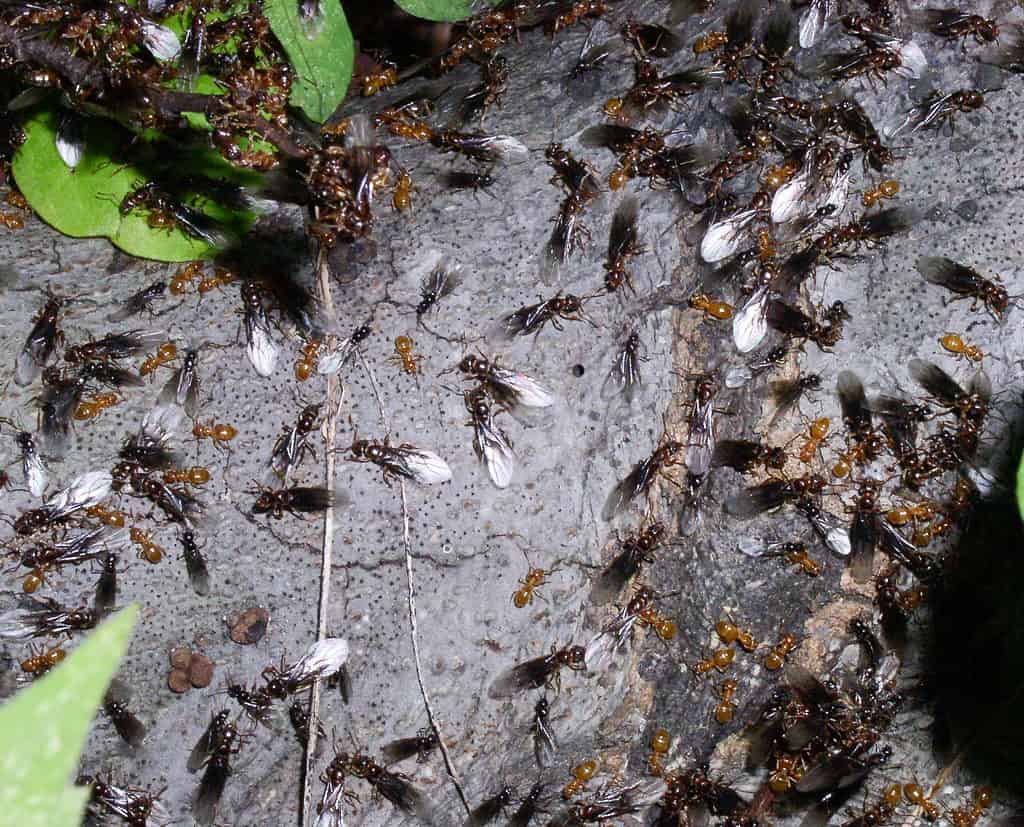
One unique characteristic of the citronella ant (
Acanthomyops) is the lemon or citrus scent it emits when crushed, hence its name.
As we head into summer in Arizona, another species of ant is going to emerge: the citronella ant. These ants sport yellow to yellowish-brown hue and irregularly rounded, segmented bodies when viewed from the front. Workers measure approximately 0.15 inches in length, while queens can be slightly larger.
One unique characteristic of the citronella ant is the lemon or citrus scent it emits when crushed, hence its name. These ants are primarily nocturnal. They prefer to construct their nests outside in damp soil near a home’s foundation, beneath concrete blocks, around logs, and under decaying trees. While they may accidentally wander inside, citronella ants generally prefer to stay outdoors and do not typically cause damage to homes.
Citronella ants have a particular affinity for honeydew and care for aphids to harvest their sweet secretions. Unlike other ant species, citronella ants do not significantly threaten human health and are unlikely to bite. They are most active from late May through early September and wander about during the peak summer months.
3. Dark Rover Ant (Brachymyrmex patagonicus Mayr)
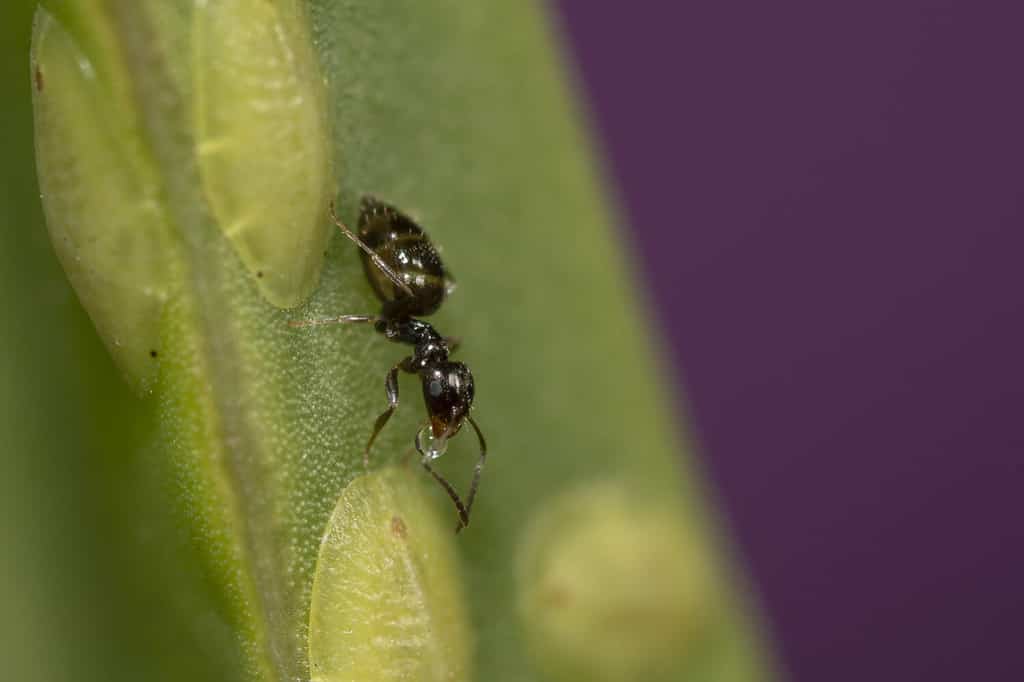
Dark rover ants eat honeydew and scale insects.
©Wirestock Creators/Shutterstock.com
The Gulf States and certain urban regions of Arizona have been infiltrated by the dark rover ant, a species that causes trouble by invading buildings with winged adult alates and foraging workers, as well as establishing nests inside.
These tiny, uniform-sized (monomorphic) worker ants range in color from black and dark brown to pale blonde and measure about 1/16″. They possess 9-segmented antennae without a club and a 1-segmented petiole beneath their abdomen. They do not have stingers.
Dark rover ants feed on honeydew secreted by aphids and scale insects, as well as proteins from other living and deceased insects. Although they live in both natural and disrupted environments, their existence appears to be more prevalent in urban regions and other human activity hotspots. These ants are commonly discovered in mulch in landscaped areas.
While these pests do not bite, sting, or spread diseases, their infestations are tough to manage, resulting in them being a significant annoyance indoors. In Arizona, the reproductive (winged) caste of the dark rover ant may emerge indoors during the spring and summer and stay till fall.
4. Western Harvester Ant (Pogonomyrmex occidentalis)
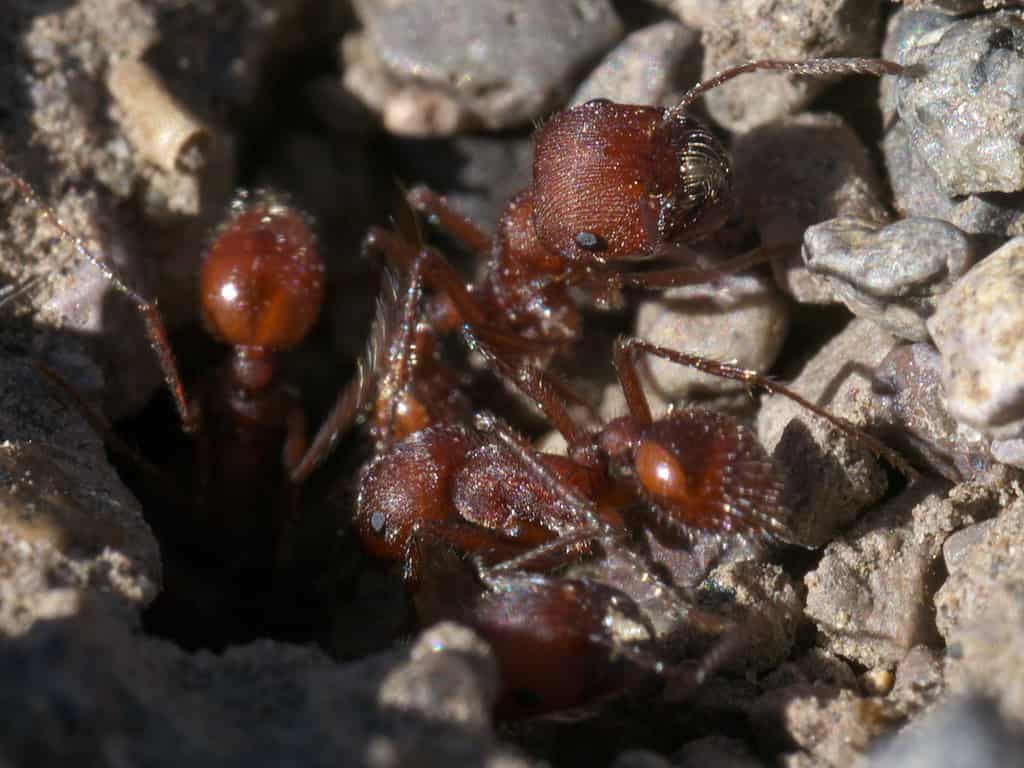
The Western Harvester Ant (
Pogonomyrmex occidentalis) is identifiable by its reddish color, which can range from light to medium, and its glossy appearance.
The western harvester ant is identifiable by its reddish color, which can range from light to medium, and its glossy appearance. The abdomen’s last few segments, also known as the gaster, are typically slightly lighter than the rest of the body. These ants form colonies with only one queen, which makes them monogynous.
Western harvester ants primarily feed on either seeds or insects, depending on the availability of their preferred food source. They have a tendency to focus on only one type of food at a time, and they can travel considerable distances in search of it.
A sting from a harvester ant can lead to the formation of painful sores, and in severe cases, an allergic reaction may occur in both humans and animals. Unlike honeybees, harvester ants can sting multiple times, and some species have stingers with reverse barbs that remain embedded in the skin, much like a honeybee’s.
In Arizona, during spring or summer, winged male and female harvester ants take to the skies, swarm, mate, and establish new colonies after periods of heavy rain. You can see these ants wondering around from March through September.
5. Southern Fire Ant (Solenopsis xyloni)
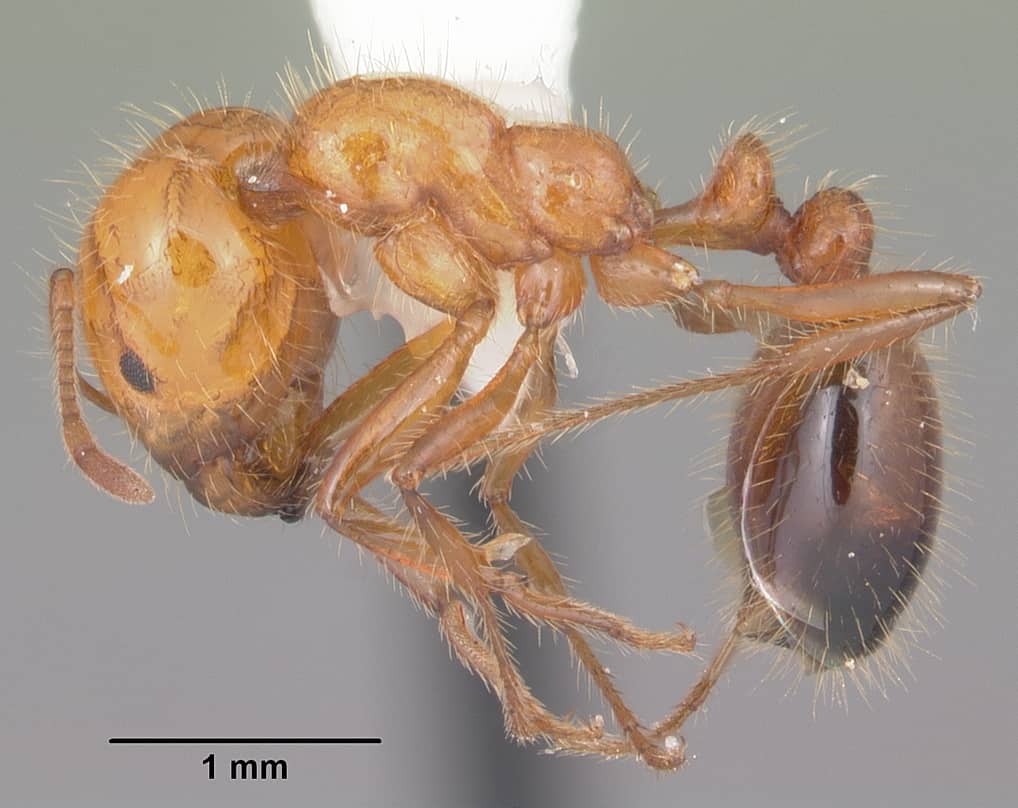
Arizona is home to the notorious southern fire ants (
Solenopsis xyloni), known for their aggressive behavior and venomous sting that leaves itchy blisters that can last for weeks.
Arizona is home to the notorious southern fire ants, known for their aggressive behavior and tough extermination. These ants possess a venomous sting that leaves itchy blisters that can last for weeks.
There is a range of sizes among worker ants, from 1/8-inch to over 1/4-inch in length, with amber-colored heads, thoraces, and large eyes. Their abdomen is mostly black and covered in golden hairs, and their petiole lacks thoracic spines and has two nodes. On the front of their head, they have two teeth.
These ants have a varied diet, including insects, sweet foods, young tree bark, grease, honeydew, and almonds. They typically create nests in small mounds or patches of loose soil near moisture, and these nests are irregular and flattened with multiple openings. They prefer warm and sunny areas.
Massive colonies of southern fire ants can contain up to 10,000 individuals and multiple queens. These ants are highly aggressive and can consume anything that comes their way. They breed quickly, with worker ants emerging just 15 days after hatching.
These ants are officially classified as pests in the United States, consuming over 300 million acres of land. They typically emerge during March in Arizona and remain active until the end of September or until the first frost.
6. Black Carpenter Ant (Camponotus pennsylvanicus)
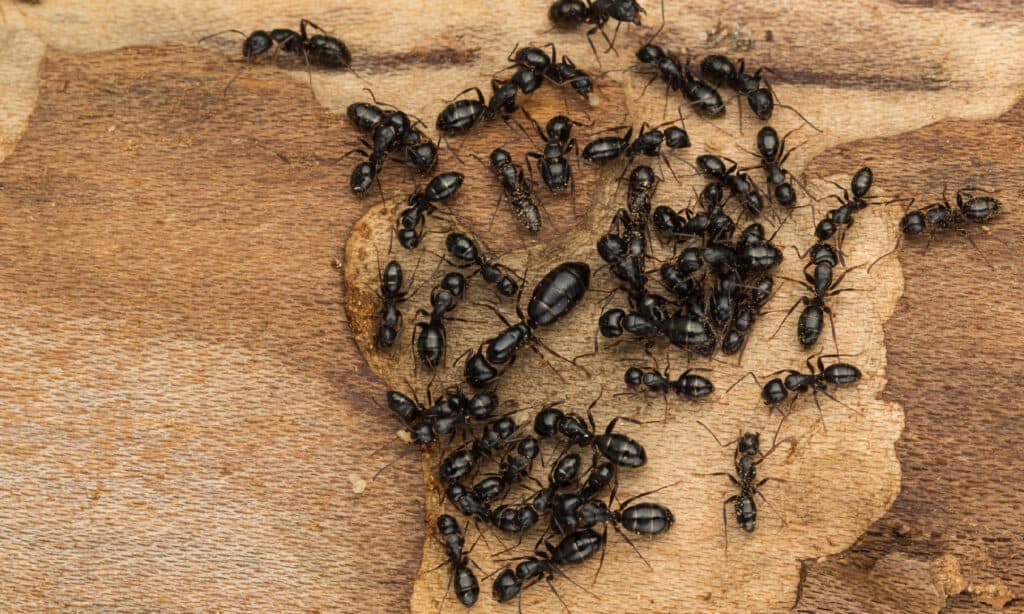
The largest species of ants in Arizona are the black carpenter ants (
Camponotus pennsylvanicus), which are experts in woodworking and live in social communities.
©iStock.com/DianaLynne
The largest species of ants in Arizona are the black carpenter ants, which are experts in woodworking and live in social communities. These creatures vary in color depending on their location and are versatile and tough.
To satisfy their sweet tooth, black carpenter ants love to feed on insects, other small arthropods, dead insects, honeydew, and nectar. These ants typically inhabit woodlands, suburban areas, and forest edges. Carpenter ants are known for nesting in wood, including indoor structures, and they can cause damage to wooden structures in order to build their nests. While they may also forage for food indoors, their presence indoors can also indicate nest establishment.
Although carpenter ants do not consume wood, they do chew on it to create their nests. It is worth noting that they can deliver painful bites, thanks to their strong jaws, and may also inject formic acid into the wound, causing a burning sensation. Nonetheless, the discomfort will eventually subside, and there is no significant threat to health.
These ants, like others, use chemical trails to locate food, occasionally traveling hundreds of feet away from their nest. In Arizona, you can spot swarmers between February and June.
Other Insects Set to Emerge in Arizona
Not just ants but some other insects in Arizona are also eagerly waiting for the arrival of summer to emerge from their hiding places.
Apache Cicada (Diceroprocta apache)

Apache cicada on tree branch. Cicadas do not bite or sting but pierce and suck on plants and other surfaces.
©David ODell/Shutterstock.com
In Arizona’s desert, the Apache cicada is a prevalent species distinguished by its dark appearance and a pale tan band situated behind its head. The males of this species produce a loud, high-pitched sound to attract female cicadas during the mating season.
Cicadas do not bite or sting but pierce and suck on plants and other surfaces. While they may occasionally mistake humans for trees and attempt to feed on them, they are not aggressive or malicious.
During the summer evenings, nymphs of the Apache cicada emerge from their underground habitats, typically from June to August or September. As they leave, they create small holes in the soil about half an inch in diameter to mark their exits. Once they reach the surface, they climb trees, plants, or buildings and attach themselves there until they molt into adulthood.
Palo Verde Beetle (Derobrachus hovorei)

The Palo Verde Beetle is a harmless insect, despite its terrifying appearance.
©Mike Ostrowski, CC BY-SA 4.0 <https://creativecommons.org/licenses/by-sa/4.0>, via Wikimedia Commons – License
The Palo Verde Beetle is a harmless insect, despite its terrifying appearance. It may cause some annoyance, though. You might have seen it lurking in your backyard, especially during the monsoon season.
These beetles come in shades ranging from brown to black and are equipped with wings that allow them to fly. They have adapted to thrive not only in their native trees but also in non-native trees. These beetles are naturally attracted to sources of light in the dark, so it is best to keep outdoor lighting to a minimum or use yellow or amber bulbs, which are less attractive to them.
Arizonans frequently encounter these beetles during the monsoon season, often finding them in their yards or even their swimming pools. They emerge from the ground during this season, searching for their mates and are remarkably large.
Red-Tailed Bumblebee (Bombus lapidarius)

In Arizona, the red-tailed
bumblebee
is a well-known species that are easy to recognize thanks to their orange-red tails.
©IanRedding/Shutterstock.com
In Arizona, the red-tailed bumblebee is a well-known species that are easy to recognize. The workers and queens are primarily black in color, but their bright orange-red tails make them stand out. The queen is larger in size compared to the workers, which can be as small as a housefly. On the other hand, the male drones have a yellow band on their thorax and yellow hairs on their face.
Unlike honeybees that leave their stingers in their targets, red-tailed bumblebees withdraw their stingers, making them less aggressive. Bumblebees are generally non-aggressive, and they rarely sting unless severely provoked.
The activity period of these bumblebees in Arizona varies depending on the location. However, in most regions, they are active from March through October. Red-tailed bumblebees are most populous in mid-summer through early fall when their colonies are largest.
Giant Mesquite Bug (Thasus neocalifornicus)

With an adult length of approximately two inches, the giant mesquite bugs are quite impressive in size.
©Pearson Art Photo/Shutterstock.com
In the arid landscapes of the desert southwest, one can frequently spot giant mesquite bugs, which are often found on mesquite trees but can also be seen on other plants in gardens and landscapes.
This particular species is the biggest land-dwelling insect belonging to the Heteroptera suborder. With an adult length of approximately two inches, they are quite impressive in size. The nymphs, which are flightless, display more intricate patterns and brighter coloration. Their aposematic white and red coloration stands out, while the adults have dark brown bodies with crimson and black striped legs and antennae.
Giant mesquite bugs found in Arizona are harmless and do not bite. They can be observed during the months of May to August, with the peak population season being June or July.
Summary of Discover the 6 Types of Ants Set to Emerge in Arizona This Summer
| Ants | Bite/Sting | |
|---|---|---|
| 1 | Pavement Ant | Causes mild discomfort |
| 2 | Citronella Ant | Unlikely to bite |
| 3 | Dark Rover Ant | Do not bite |
| 4 | Western Harvester Ant | Can sting multiple times causing blisters and allergic reactions |
| 5 | Southern Fire Ant | Venomous sting causes long-lasting blisters |
| 6 | Black Carpenter Ant | Bites are painful and cause a burning sensation |
Thank you for reading! Have some feedback for us? Contact the AZ Animals editorial team.








